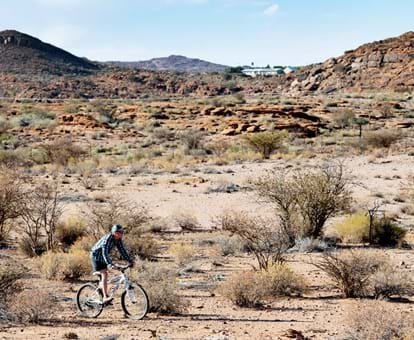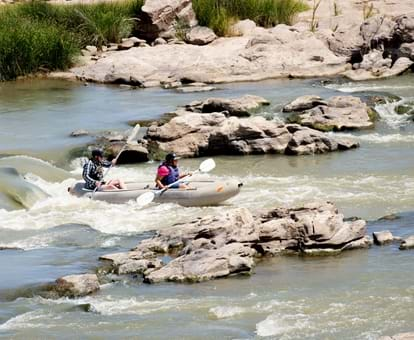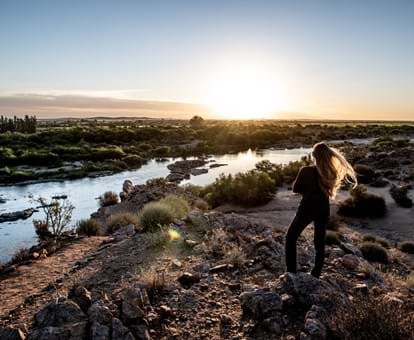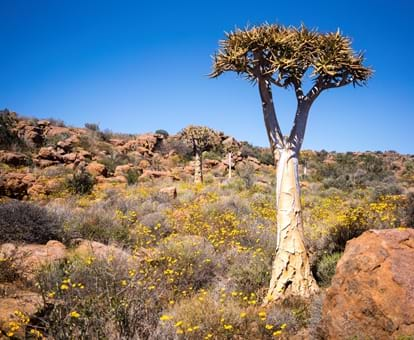By creating an account, I agree to the
Terms of service and Privacy policy
Choose your country and language:
Africa
Americas
Asia Pacific
Europe
WWhether you explore the ancient food culture of the Khomani San or prop up the bar at the venerable Kimberley Club, the food terroir of South Africa’s Northern Cape province offers food fundis a platter of unique epicurean opportunities and delicious traditional dishes.
As you seek to understand the food terroir of Northern Cape, you’ll come to the delicious realisation that in this province, nothing is as it seems.
Northern Cape is predominantly arid, and what arable land there is, is used to farm cattle and sheep, and to stock game for safaris or hunting. The red sands of the Kalahari appear empty, but for those who care to look, Northern Cape food terroir offers a plethora of ancient and unique tastes.
In the north-western reaches of the province, adventurers can discover the ancient culinary culture of the Khoikhoin. Descended from the earliest San hunter-gatherers, Khoikhoin cooks use indigenous edible flowers, plants and bulbs, known as veldkos (outdoors/’field’ food), to create delicacies like num-num preserve, agurkie jam, and kukumakranka liqueur.
TThe essence of Northern Cape food can be eaten in the Karoo. The word Karoo is a Khoikhoin term meaning thirsty land, but the apparently arid plains are filled with liquid-retaining indigenous edible plants. The diets of Karoo goats and lambs, which are so good to eat, are rich in these plants, including wild mint, wild garlic, buchu and purslane.
Those wishing to sample regionally specific cuisine should stop off at the Hantam Huis in Calvinia, where kambro preserves are served alongside wild rosemary-infused venison and roasted sheep’s head. Tswalu Kalahari Reserve and the Rooipan Guesthouse outside Upington offer n’abbas, the desert truffle that’s unique to the Kalahari.
It’s not all ancient cultures and indigenous roots, however. Gourmet glamour also has a place in the Northern Cape food terroir.
Kimberley, the centre of South Africa’s diamond industry in the 19th century, saw fortunes made and lost, and while the role of mining in the city has considerably diminished, retro-chic gourmet is still on the menu at the venerable Kimberley Hotel and the Star of the West bar.
The Green Kalahari Region of Northern Cape contrasts rust-red soil with the green vines of the Orange River Wine Route. Delicious dried fruit is to be found in Kakamas, and in Upington chilly evenings draw hungry diners to the fireside for roosterkoek (griddle cakes) venison ‘potjies’ (potjiekos is a rich, layered stew cooked in a 3-legged cast-iron pot over the fire), roasted legs of lamb, and slow-cooked pens-en-pootjies (tripe and trotters) stew.
TTravel tips & Planning info
Who to contact
Northern Cape Tourism Authority
Tel: +27 (0)53 832 1434
Email: marketing@experiencenortherncape.com
Die Hantam Huis, Calvinia
Tel: +27 (0)27 341 1606
Email: hantamhuis@calvinia.co.za
Rooipan Guesthouse
Tel: +27 (0)82 415 1579
Email: rooipan@gmail.com
Tswalu Kalahari Game Reserve
Phone: +27 (0)53 781 9331
Email: res@tswalukalahari.com
Kimberley Club at the Kimberley Hotel
Tel: +27 (0)53 832 4224
Email: reception@kimberleyclub.co.za
How to get here
Both Kimberley and Upington have air links with all major South African cities. Kimberley also has rail links with major South African cities. The best way to travel around Northern Cape is by car, however, so that you can take your time and enjoy the vast space.
Best time to visit
Spring (September to November) and autumn (March to May) are the coolest seasons. December to February can be scorching, and winter from June to August, though sunny and warm during the day, sees temperatures plummet at night.
Tours to do
A tour of the Orange River Wine Route with tastings and cellar visits. Local tourism authorities will also be able to direct you to any tours in the area offering regional cuisine or demonstrations of traditional plant use as herbs and medicine.
Get around
Northern Cape is huge, so self-drive is recommended. Some areas require 4x4 (SUV) vehicle access.
What will it cost
Meal prices vary enormously, depending on what's on the menu. Expect to pay anything from a under R50 to a couple of hundred rands – the latter for 3-course fine dining with top wines included.
Length of stay
Northern Cape is not a weekend destination. Plan to spend at least 1 week.
What to pack
Sun protection is recommended all year round. In summer, carry extra bottled water.
Where to stay
Because of the vast distances, outside Northern Cape's towns and cities most accommodation is in the form of guest houses or farm stays. Staying in a Khoikhoi grass hut is one of the more unusual options, while Tswalu Kalahari Reserve has three 5-star lodges.
What to eat
From May to April, if seasonal rains have been good, try n'abbas, (Kalahari truffles). Other traditional delicacies include roosterkoek, skilpadjies (‘tortoises’: lamb’s liver wrapped in caul fat, similar to a faggot), stertjies (lambs’ tails) and peertjies (lambs’ testicles: literally, ‘little pears’).
Best buys
Orange River Cellar wine, Kalahari gourmet salt, biltong, lamb and venison.
Related Links
- Calvinia Tourism
- The Kimberley Club
- Orange River Cellars
- Eat Out Restaurant Guide
- Tswalu Kalahari game reserve
Planning a trip to South Africa? Meet Your South Africa guides, the people that know the country best! Read the Meet Your South Africa magazine here
__________________________________________________________________________________
For inspiration and insider tips, follow us on Instagram, Facebook, or Twitter. Tag #MeetSouthAfrica to share your pics with us, or subscribe to our newsletter for latest information, great holiday offers, prizes and consumer events across South Africa.

|Terms and conditions|Disclaimer|Privacy policy|Social Media Terms and Conditions|Competition Terms and Conditions






